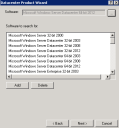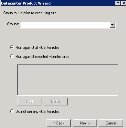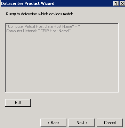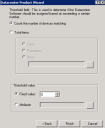Virtual-licensing rules overview
To save on infrastructure costs, many organizations use virtualized environments. Because vendors have different licensing policies when it comes to virtualization, these environments can present a challenge for ensuring software licensing compliance and for finding your organization's most cost-effective licensing options. DTS can help resolve these issues.
Getting started
To manage licenses within your virtualized environment, you'll need to configure two types of rules:
- VMWare vCenter rules connect to your vCenter database and import ESX host server and virtual device information into the inventory database.
- Datacenter product rules apply a vendor's advanced licensing policies to your software, finding the most cost-effective licensing options for your organization.
Configuring VMWare vCenter rules
The first issue in handling a virtualized environment is configuring a rule that imports your vCenter database information into the inventory database. You must do this to determine which devices are virtual and the ESX host server they're associated with.
DTS will need read-only access to the vCenter database.
As this rule runs, it will perform the following tasks:
- Create inventory records for all ESX host servers in the vCenter database by collecting the data necessary to perform software licensing, such as processors, cores, and images currently assigned to each virtual host. These new records will appear in the network view under Virtual OS Hosts.
- Determine which records in the database are assigned to which virtual host server. When you look at the inventory for a virtual host, you'll see a new attribute—under Virtual Host Data, the Host Name attribute will be populated.
- Create records of the processors and cores that have been assigned to the virtual host server. The key field imported is Computer.Process.Features.Total Cores, which is the number of cores that have been assigned to the image.
For more information, see VMWare vCenter import wizard.
Configuring Datacenter product rules
The second issue in handling virtualization is configuring a rule that applies a vendor’s advanced licensing policies to the software in such an environment, helping you find the most cost-effective licensing scenario.
The key concept is that a vendor’s license may cover more than one device; for example, if you have a virtual host in inventory and many images in the database that run on that host, you may need just one license to cover all of the images.
For more information, see Datacenter product wizard.
How these rules work together
To better understand how these two rule types work, you can take a look at a Datacenter product rule that ships by default with DTS. Open the Datacenter Products > All Rules folder, double-click the Microsoft Windows Server Datacenter Virtual Environment Consolidation rule, and click the View only button.
Viewing the rule configuration
This rule encodes the following Microsoft licensing policy: If you have an ESX server running a Windows Server image, you can buy one Windows Server Datacenter license instead of a license for each Windows Server image. A Datacenter license enables you to run as many Windows Server images as you want on that physical device, eliminating the need to buy a license for each processor in the host.
You'll notice that the first wizard page shows the product you're licensing, in this case, Microsoft Windows Server Datacenter 64-bit 2012. The list below the product includes the software to look for that is covered by this license, in this case, all Windows Server OSes.
You'll notice the next page enables you to run this rule against your vCenter rules. In this case, you're running it against all configured vCenter rules.
The next page shows a query that links multiple records in the database. In this example, you’re concerned with devices where the host’s Computer.Network.TCPIP.Host Name is the same as the virtual image’s Computer.Virtual Host Data.Host Name.
The final wizard page displays the threshold values for assigning Datacenter software to "collapse" the licenses. In this case, Count the number of devices matching is selected, which means the number of devices that are assigned to this host that have a Windows Server OS installed.
Before and after running the rule
By default, the nightly Data Analytics software-manager service performs a licensed-software detection on all rules in the Licensed Software > All Rules folder; in this example, the service picks up all images and the Windows OS licenses they need.
Before you run this rule, if you look in inventory under Licensed Software or in the Executive Report Pack report for OSes, you'll see all the virtual devices listed with the proper OS.
After you run the rule, a different result occurs. At that point, if a virtual host has at least one Windows Server OS product associated with it, the host will be assigned a copy of Windows Server Datacenter 64-bit 2012 and the associated virtual images will have their Licensed Software Windows OS entry removed. You should be able see the results in the same report as well.



